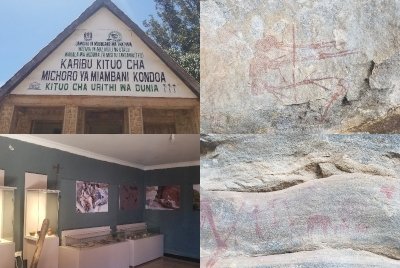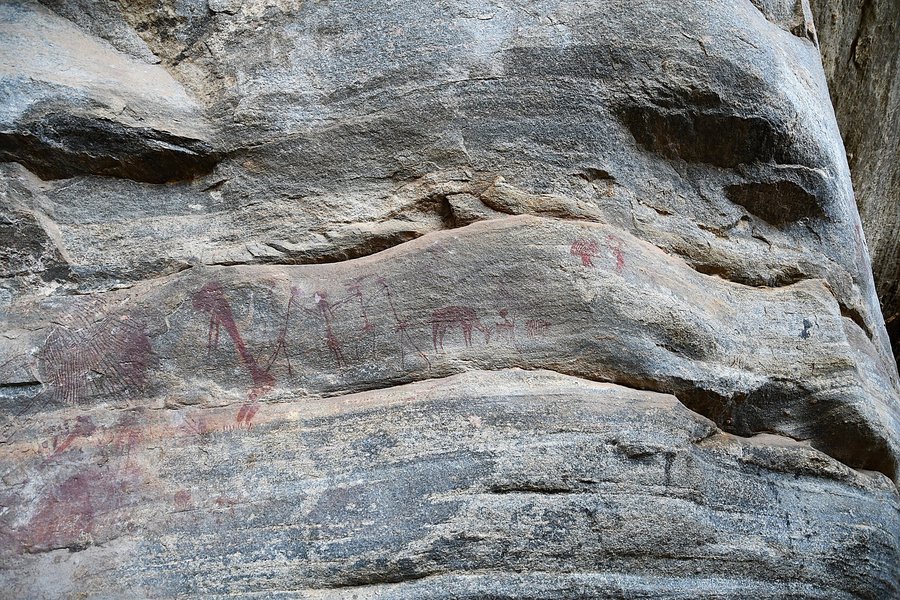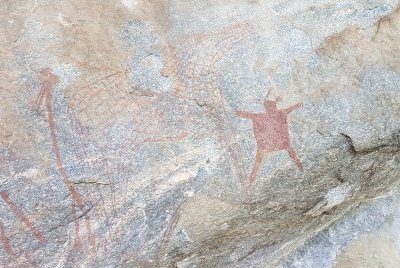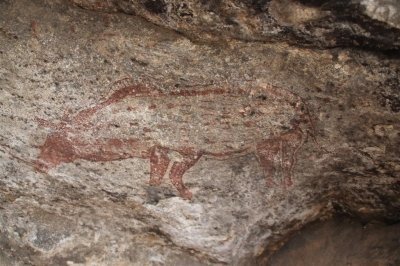Tanzania
Kondoa
The Kondoa Rock-Art Sites include over 150 natural caves or shelters that have been used for rock paintings for at least two millennia.
The paintings have high artistic quality and were made with a brush-like instrument. They depict elongated people, animals (some domesticated), and hunting scenes. Some of the sites still have a ritual meaning for the local population.
Community Perspective: the sites can be accessed from the village of Kolo, where the visitor center is and from where you have to pick up a guide. The access roads to the various clusters are not in good condition. Thomas has described how to visit on public transport.
Site Info
Official Information
- Full Name
- Kondoa Rock Art Sites (ID: 1183)
- Country
- Tanzania
- Status
-
Inscribed 2006
Site history
History of Kondoa
- 2006: Inscribed
- Inscribed
- 2005: Referred
- To provide a site record system, conservation plan, site manager, buffer zone etc.
- Type
- Cultural
- Criteria
- iii
- vi
Links
- UNESCO
- whc.unesco.org
- Related
-
- ntz.info — Figurative representation of the paintings
- bradshawfoundation.com — Introduction to Tanzanian rock paintings
- trip101.com — Visiting Kondoa Rock Art Sites In Tanzania As An Independent Traveler
All Links
UNESCO.org
- whc.unesco.org — whc.unesco.org/
Related Resources
- ntz.info — Figurative representation of the paintings
- bradshawfoundation.com — Introduction to Tanzanian rock paintings
- trip101.com — Visiting Kondoa Rock Art Sites In Tanzania As An Independent Traveler
Community Information
- Community Category
- Archaeological site: Rock Art
Travel Information
Guided Tour Only
Recent Connections
-
Guided Tour Only
You have to pick up a local guide at th… -
Built in the 1st century
earliest estimates -
Cultural sites connected to Cliffs
The exact number of rock art sites in t…
Connections of Kondoa
- Individual People
-
-
Leakey Family
The Leakey family, with the financial support of Norwegian Aid, organised the construction of a small rock art visitor centre at Kolo in the 1970s. Mary Leakey was the main specialist there
-
- Trivia
-
-
Largest cultural WHS
233,600 ha
-
- World Heritage Process
-
-
First sites filling gaps cited by ICOMOS
African rock art 2006
-
- Human Activity
-
-
Pastoralism
a unique form of agro-pastoralist paintings (AB ev) -
Language isolate
Sandawe (formerly considered a Khoisan language, now established as an isolate). The Sandawe are historically connected to the rock paintings and are mentioned in the description of the site. -
Pictographs
-
Hunter-gatherers
The spectacular collection of images (...) displays sequences that provide a unique testimony to the changing socio-economic base of the area from hunter-gatherer to agro-pastoralist, and the beliefs and ideas associated with the different societies. (official description) -
Iron production
Remains of Iron Age smelting furnaces, tuiyeres, slag were found
-
- Constructions
-
-
Cultural sites connected to Cliffs
The exact number of rock art sites in the Kondoa area is not yet known but it is estimated that there are between 150 and 450 decorated rock shelters, caves and overhanging cliff faces." (OUV)
-
- Timeline
-
-
Built in the 1st century
earliest estimates
-
- Visiting conditions
-
-
Guided Tour Only
You have to pick up a local guide at the entrance, who will accompany you in your car to the sites.
-
News
No news.
Community Reviews
Show full reviews
Kondoa was one of the reasons I chose to self-drive in Tanzania because it's quite away from the other sites and I didn't want to arrange a separate tour for just this site alone - but in hindsight it takes a lot of driving on rather crappy traffic-laden roads around central Tanzania and one could just get a driver from Dodoma. It won't cost you that much more especially if you are in a smaller group. It turns out that you must have a car when you get to the site and you drive that super bumpy road (even taking a toll on 4WDs!) to the real site which might not be the best for your rental agreement. When you get to the museum you pay for PARKING (!?), the site permit, a mandatory guide (decent English and knew the site well) and I think even permit for your car to enter the park area...like..whaaaat?! The prices suddenly seem quite steep what was supposed to be a quick look-see of rock art, and that's pretty much what you get to see. You can only drive to ONE site and it's up the hill in the area beyond the little town. The road is rough and if you are out of luck you have oncoming vehicles on the way too. There is eventually a small parking area with a lovely map and some information plus a shaded hut used for groups to listen to a guide. In my case we went …
Keep reading 0 comments
Kondoa Rock-Art Sites WHS. A series of ancient paintings on rock shelter walls in central Tanzania nine kilometres east of the main highway (T5) from Dodoma to Babati.
The landscape is large piled granite boulders on the western rim of the Maasai steppe and form rock shelters facing away from prevailing winds. These rock shelters often have flat surfaces due to rifting, and these surfaces are where the paintings are found, protected from weathering.These paintings are still part of a living tradition of creation and use by both Sandawe in their simbó healing ceremonies, and by Maasai people in ritual feasting. About 1970, Sandawe men were still making rock paintings. The reasons were magical (depicting the animal that the painter intended to kill), casual, and sacrificial (on specific clan-spirit hills and depicting rain-making and healing ceremonies).The paintings depict elongated people, animals, and hunting scenes. Older paintings are generally red hunter-gatherers superimposed by Bantu white cattle.Individual sites include Kisese II Rockshelter: paintings, beads, lithics, pottery, and other artifacts. Used for the burial of seven Holocene individuals. Evidence of occupation on the floors dated to more than 40,000 years ago.One of the paintings depicts a human figure holding a stick and an elephant. Nash commented on the peaceful posture of the human, doubting that the drawing was intended to depict a hunting scene. Other paintings portray giraffes, a possible rhinoceros fragment, a humanoid figure composed of concentric circles in the head and continuous lines from the top of the head to …
Keep reading 0 comments
The Kondoa rock art site has been thoroughly reviewed already. Two things I would like to add. Firstly I found the entrance price quite steep. We were coming with our driver from Dodoma and not only had to pay for our own entrance fee, but seperatly for the car, our driver and the guide, which totalled 93.000 TSH ( around 40€). A second, more interesting point is that the Rock paintings have only suffered from wheather related causes, mainly rain seeping through the rocks, but not from human causes. The reason for this is that even nowadays, thousands of years after they were made, they still play a role in religious practices. Just below the B1 site there is a rock with a hole underneath, were according to the locals a deity lives. We saw people entering the cave, and if the deity approved the goat and chicken they brought with them would be slaughtered. It was my first visit to a WHS were i could witness the preparation for an animal sacrifice.
Keep reading 0 comments
I like to focus on the practicalities of reaching this rather remote WHS by public transport. It is not too difficult. Buses go from either Dodoma or Arusha, and they leave early in the morning in either direction for a couple of dollars. Shabiby is by far the best. Dodoma is about an hour closer than Arusha to the Kondoa rock art sites. The visitor center is actually in Kolo, right on the main road, and this is the place where you have to get off the bus, register and pay your fees. About USD 13 for the guide who accompanies you, and we also paid about USD 21 for 3 motorbikes bringing us on a rough road to the foot of the hill where the caves are located. We chose the B group consisting of 3 caves, about 90 minutes walk uphill and down again. I was told that normally it is possible to rent a car from the visitors centre, but that it was in repair during our visit. There is also an entrance fee. The main headache was to catch an onwards transportation from Kolo as most long distance buses have passed already in the afternoon, and we had to wait almost an hour, but then found a smaller local bus all the way to Arusha. Babati would be an option to sleep in case there are no more buses, but this is highly unlikely. We reached Arusha before sunset after about 7 hours on the bus …
Keep reading 0 comments
Visiting the popular Tanzanian WHS has the disadvantage that it is difficult to organize it yourself - the best, and sometimes the only option, is to buy a safari. This is not my favorite sightseeing style, and when a travel agent offered me $ 500 for a 2-day trip to Kolo from Arusha, I had no hesitation in renting a car and driving there on my own. The rental itself is also not the cheapest - the standard rate for the smallest Toyota Rav 4 variant is $ 80 per day, but it gave me the freedom I wanted.
The road to Kolo is about 250 kilometers, which I covered in less than 4 hours. Even though the road is very nearly perfect, it is not worth going too fast, especially in residential areas - the Tanzanian police love to catch drivers in the least expected way. I paid fine twice - once caught by a policeman sitting in a truck, the second time when he took a picture of me perfectly on the line of the speed limit sign. "This is Tanzania, man," one of the drivers caught in the limitation told me. The fine is 30k TZS (approximately $ 12), regardless of the offense.
The Visitors Center is right on the Arusha-Dodoma road, it is impossible to miss it. There are supposedly a few guides waiting on site, so you don't have to book anything in advance - especially since, as I saw in the book …
Keep reading 0 comments
We visited the Kondoa rock art site from Arusha with a rented car. The archaeological museum where guides to visit the site(s) can be found is actually in Kolo, a little village 25 kilometres on the main road before you reach Kondoa. The whole stretch Arusha – Kolo is in very good condition and took us about 3.5 hours.
As we were told that the Thawi sites have the most varied paintings, we opted for these sites (more specifically sites D4A, D4B, D14 and D15). The downside is that these are probably one of the most remote sites which can be visited and a 4x4 is required – no way the area can be reached with a standard car. Taking this into account, the 20 kilometre drive (one way) took about one hour.
As mentioned above, you can first pick up a guide at the Kolo archaeological museum and he/she accompagnies you in your car to the sites. Not only is this useful for background information about the paintings, but also absolutely necessary to find the sites since the (Thawi) sites are not indicated in any way. Once arrived in the area, also a 15 minute downhill walk is required to reach the paintings.
The drawings in red paint show mostly animals (giraffes, rhinos, a bird’s head, ...), but also human figures. The absolute highlight is a very detailed painting of a rhino which still is in amazing condition. Since these sites are so remote and located …
Keep reading 0 comments
Kolo is a small village along the 'highway from Arusha to Dodoma (Capital of Tanzania) The road is very bad although they say the Chinese will be paving the road in the next couple of years (2016?)
It takes about 3 hours to get to Kolo from Arusha by 4 wheel drive (224km) and another 3 hours to get from Kolo to Dodoma (180km).
There are 185 sites with rock paintings in the Kondoa region but only a few are accessible for tourists unless you intend to hike out in the bush. Mary Leakey began documenting these rock paintings in the 1950s and when she was done, the conclusion are that these were the second most extensive rock painting sites in Africa next to Tassili N'Ajjer in Algeria. There is now a small museum in Kolo right at the only junction in town. It has a couple of rooms with some stone tools and artifacts and pictures of some of the the rock paintings.
The problem is that the most popular site (B1, B2 and B3) is 9 km out of Kolo. It is also very bad road to the site and requires a 4 wheel. You pick up a guide at the museum to go with you. There is a bus that runs between Arusha and Dodoma and can drop you at Kolo. The problem is that there is no transportation to the site. I was told you can try to get a motorcycle taxi to get you out …
Keep reading 0 comments